RBA Annual Conference – 2000 The Australian Labour Market in the 1990s Peter Dawkins[1]
1. Introduction: Unresolved Issues
Since the mid 1970s the historically high unemployment rate in Australia has been a major issue of concern to policy-makers. A related issue has been the widening distribution of employment with substantial growth in the number of households with no employed persons, alongside strong growth in the number of households with two or more persons working. There has also been a widening distribution of earnings amongst the employed workforce.
As a result there has been much discontent about labour market outcomes. This has led to a lively debate about labour market policy, but a lack of consensus about how to approach it. In the 1980s the Labor Government adopted a Prices and Incomes Accord to help contain inflation while promoting growth and employment. After the recession of the early 1990s, a major investment in labour market programs, Working Nation, was embarked upon, with the aim of promoting a substantial reduction in unemployment, which had gone above 11 per cent. On the face of it these policies represented an interventionist approach. At the same time, however, after a short period of very centralised wage fixing in the early years of the Accord, the Labor Government promoted a move towards more decentralised wage determination through enterprise bargaining, while still retaining the Accord with the Australian Council of Trade Unions (ACTU).
When the Coalition Government came to power in 1996, it substantially cut the Working Nation labour market programs, but kept pushing ahead with labour market reform, this time without the consent of the ACTU, seeking to further decentralise and deregulate wage setting, while at the same time reducing the powers of trade unions. It also introduced Job Network – a market-oriented approach to the provision of employment services.
It appears therefore that there has been a significant move towards a more free-market orientation. However, Australia still retains a structure of minimum wages at a high level by international standards, and the Government has been favouring regular increases in these minimum wages especially at the lower levels.[2] The Government remains concerned about the level of unemployment and of ‘welfare dependency’ and is looking for ways of moving people from welfare to work. It is not clear that it necessarily sees moving towards a freer labour market as the way forward. This is probably because of the problem of trying to balance efficiency and equity in labour market outcomes and also because of problems of getting legislation through the Senate. Nonetheless the Minister for Employment has been foreshadowing a possible further deregulation of the labour market, by bringing wage setting and industrial relations regulation under the domain of the Federal Government's corporations power under the Constitution.
Meanwhile, the Opposition has been critical of the cuts to labour market programs and appears to favour restoring more powers to centralised wage setting and industrial tribunals. Thus the debate about the proper role of government in influencing labour market outcomes remains an open one.
To all this, it should be added that there is a growing awareness of the importance of macroeconomic policy in influencing labour market outcomes. In particular, the role of monetary policy in seeking to avoid a recession is seen as of central importance.
In this paper I will argue that while there are a number of unresolved questions, there are some very strong economic and institutional dynamics that are tending to lead policy in a certain direction, and that it will be difficult for governments to resist it whatever their complexion. Nor in the author's view should they try to resist it.
Technological change, trade liberalisation and globalisation[3] have been forcing economic reform and assisting productivity growth, while tending to widen the distribution of employment and the distribution of earnings.[4] In this environment skills are increasingly important and education and training policy are, therefore, of major importance. However successful the education and training policies are, though, it is very difficult to resist the pressure for more decentralised wage determination and a widening distribution of earnings. Any attempts to do that risk worsening the distribution of employment opportunities.
This then raises important questions about how to deal with equity concerns, arising out of the tendency for the distribution of earnings to widen, the more so the more we deregulate the labour market. In other words, can we avoid the diabolical trade-off? Following Dawkins and Freebairn (1997), Dawkins (1998, 1999), Dawkins et al (1998), Garnaut (1998), and Keating (2000), it is argued that the appropriate use of tax or social security arrangements, to deal with these equity concerns, is the answer. This should be done in a way that also sharpens the incentive to work, and helps to get unemployment down along with a number of other instruments. This was also a central thrust of the plan put forward by the ‘five economists’[5] in 1998.
Trends in aggregate labour market outcomes are the focus of Section 2 of the paper. Similarities to and differences from the 1980s are highlighted. In Section 3, labour market institutions and policies in the 1990s are the focus. Changes from the 1980s are again highlighted. In Section 4, there is a discussion of the drivers of labour market outcomes and the role that institutions and policies may or may not have played in that process. In Section 5, unresolved issues and alternative ways of resolving them are discussed. In Section 6 the conclusions are presented.
2. Trends in Labour Market Outcomes in the 1990s: Similarities to and Differences from the 1980s
In this section an overview is presented of trends in aggregate labour market outcomes in the 1990s. Of particular interest is how some of the trends in the 1990s were quite different from the experience of the 1980s and some were very similar.
2.1 Similarities
The time pattern of aggregate employment and the unemployment rate in the 1990s followed remarkably similar paths to the 1980s (Figures 1 and 2). The recession at the beginning of the decade led to a big jump in the unemployment rate in a short period of time – a very similar experience to the recession of the early 1980s. This was followed by a slower but steady reduction in unemployment in the remaining years of the decade, again a very similar experience to the 1980s. The size of the employment growth after the recession in the early 1990s was not as large as the employment growth enjoyed between 1983 and 1990, a point that is developed more in Section 2.2.
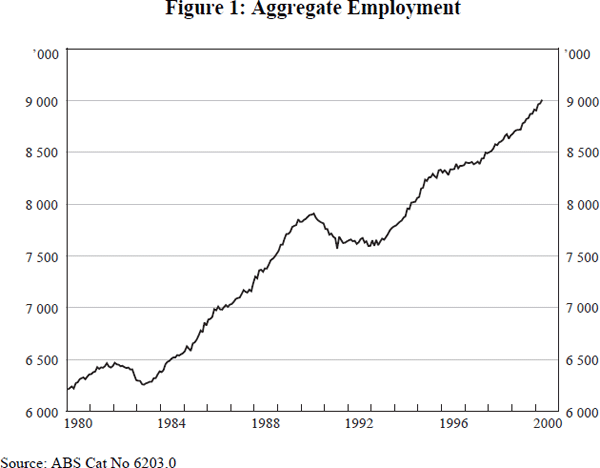
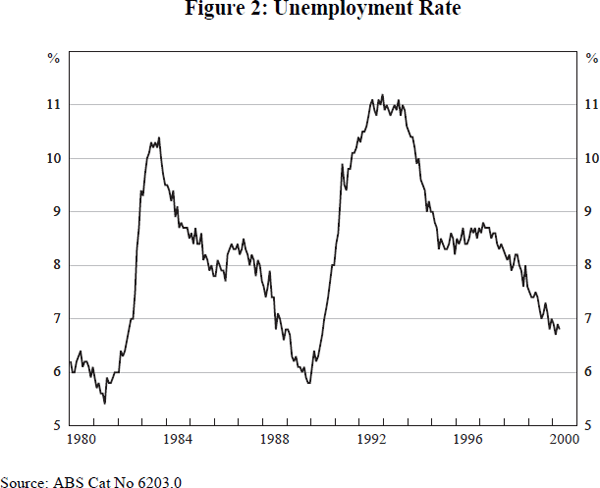
Another similarity is the growth of part-time employment and in the hours of work of full-time employees. The incidence of part-time employment has continued on its long-run upward trend (Figure 3), with the absolute numbers of part-time employees approximately doubling over the two decades, and with only a very minor dip in the recession at the beginning of the decade. Average hours of work of full-time employees have also risen in the 1990s as they did in the 1980s (Figure 4), although since 1994 it appears the upward trend has slowed and may have halted in the last year or two.
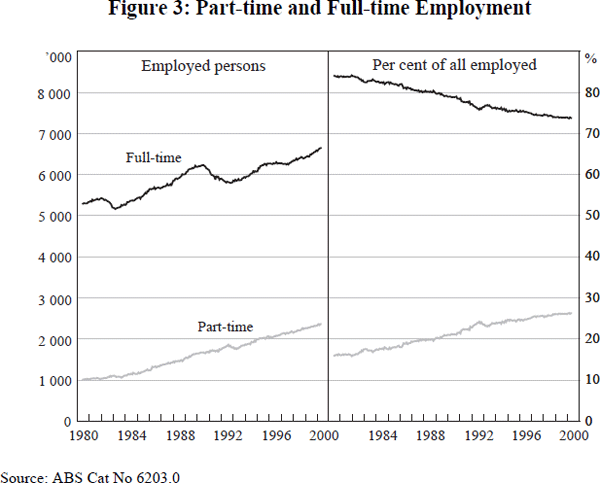
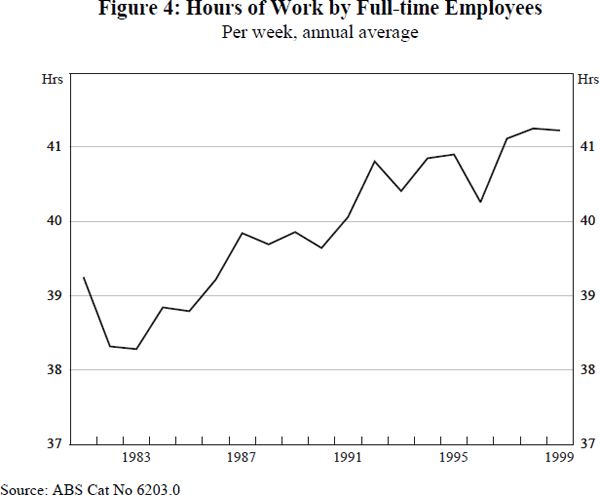
A third similarity relates to the widening distribution of earnings of full-time employees (Table 1). Looking at the first and last columns in Table 1 it can be seen that for both male and female non-managerial workers, the earnings of the lowest decile in the distribution have continued to fall relative to the median. Similarly the earnings of the highest decile have risen relative to the median.
| Lowest decile | Lower quartile | Upper quartile | Highest decile | |
|---|---|---|---|---|
| Males | ||||
| 1975 | 76.0 | 85.6 | 121.1 | 141.2 |
| 1980 | 73.8 | 84.0 | 123.2 | 150.4 |
| 1985 | 72.5 | 80.7 | 125.7 | 154.1 |
| 1990 | 69.5 | 80.6 | 126.0 | 156.3 |
| 1995 | 67.7 | 79.4 | 127.8 | 160.7 |
| 1998 | 65.5 | 78.4 | 128.7 | 162.6 |
| Females | ||||
| 1975 | 80.2 | 88.8 | 115.3 | 136.5 |
| 1980 | 81.8 | 88.0 | 119.3 | 142.8 |
| 1985 | 78.6 | 87.3 | 121.2 | 147.9 |
| 1990 | 74.9 | 84.1 | 123.1 | 147.6 |
| 1995 | 73.4 | 84.1 | 125.3 | 152.0 |
| 1998 | 71.8 | 82.3 | 127.5 | 150.4 |
|
Source: Norris and McLean (1999) |
||||
A fourth similarity is that there has been an ongoing increase in the concentration of employment into ‘job-rich families’ and ‘job-rich communities’ and of ‘joblessness’ into ‘jobless families’ and ‘job-poor communities’ (Dawkins 1996; Gregory and Hunter 1995; Miller 1997; Reference Group on Welfare Reform 2000a).
Figure 5 shows how the number of income units in Australia with no job has increased substantially between 1982 and 1997, as have the number of income units in which there are two job-holders, illustrating this widening distribution of jobs. The only type of income unit where there has been substantial growth in just one person working, is the single adult (without child) income unit.
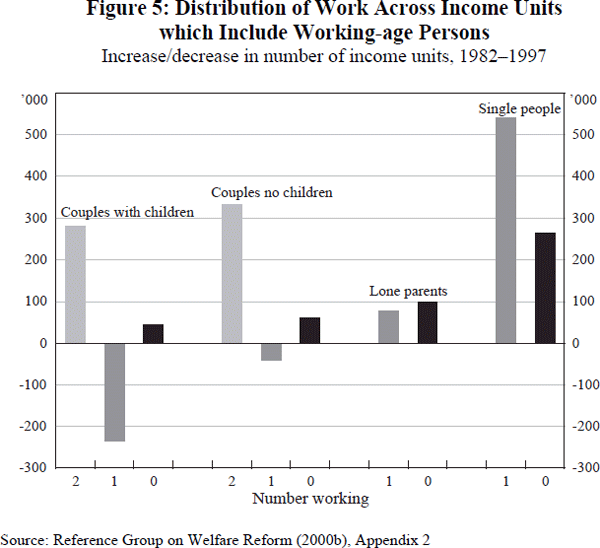
By June 1999, about 160,000 couples with dependent children had neither parent in paid work and there were 280,000 jobless lone parent families. These households contained around 860,000 children, representing 17 per cent of dependent children in Australia (Reference Group on Welfare Reform 2000a).
2.2 Differences
Just as some of the above similarities are striking, some differences are striking as well.
First, the size of the employment growth after the recession in the early 1990s was not as large as the employment growth enjoyed between 1983 and 1990 (Figure 6), although the continuation of the employment growth in 1999 and 2000 makes it a longer expansion period.
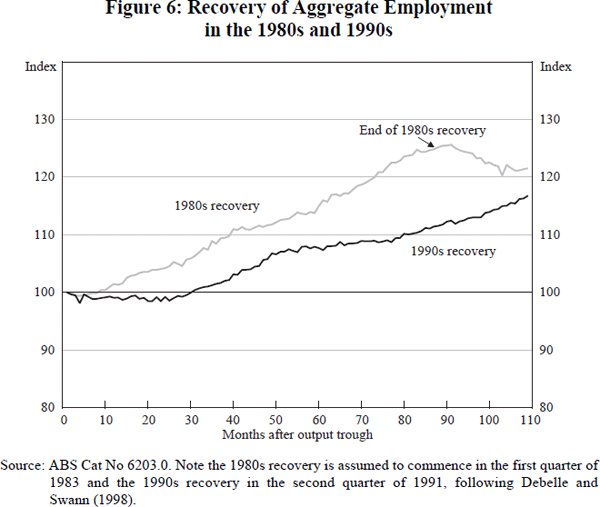
The next and probably most striking difference concerns the trend in the labour force participation rate, which changed a great deal in the 1990s compared with the 1980s. In the 1980s there was a reduction in participation during the recession, followed by quite a large increase over the remaining years of the decade. By contrast in the 1990s, while there was again a reduction during the recession, in the recovery it almost returned to its previous peak but has failed to increase further, stagnating after 1995 (Figure 7). Along with the slower growth in the population of working age[6], this has enabled the unemployment rate to fall by about as much as it did in the 1980s, without requiring quite such a large increase in employment.
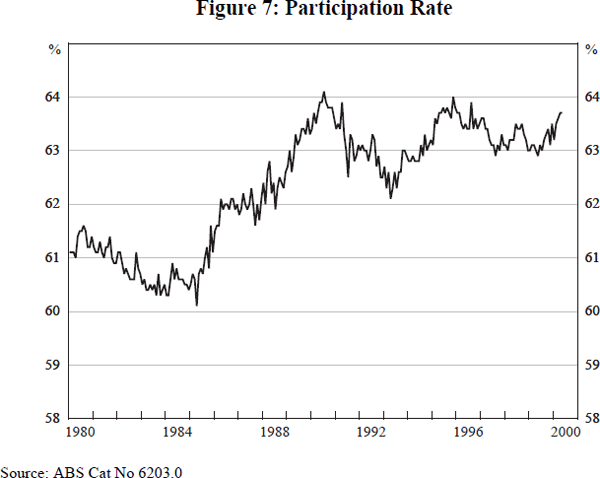
The difference in trends in the participation rate between the two decades was dominated by the behaviour of female participation (Figure 8).
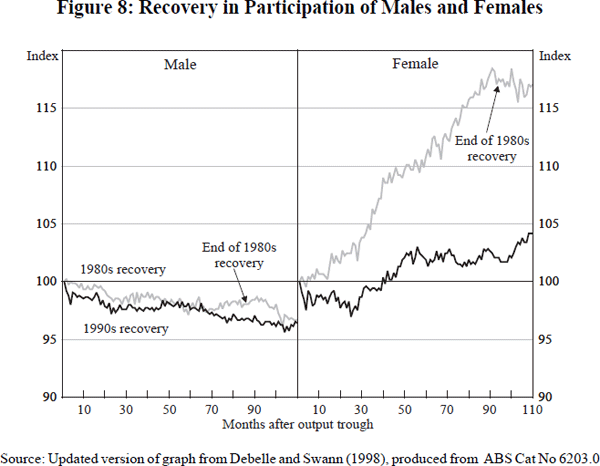
The next difference is that the reduction in unemployment took longer in the 1990s recovery than in the 1980s (Figure 9). The fact that unemployment came down as much as it did, despite the slower growth in employment, was largely due to the sluggishness of the participation rate.[7]
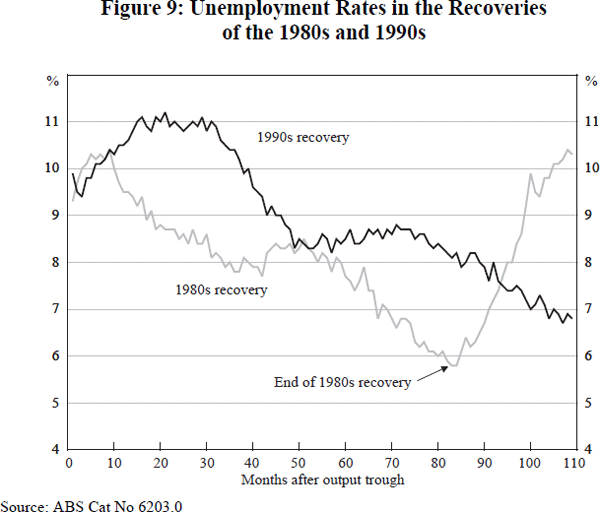
Further, while in the 1980s the employment expansion and reduction in unemployment was accompanied by a reduction in hidden unemployment (as proxied by either ‘discouraged workers’ or the ‘marginally attached’), especially amongst females, this has not been a feature of the employment expansion in the 1990s (Figure 10). Furthermore, underemployment, as measured by the percentage of employees who would like to work more hours, increased significantly during the recession of the early 1990s and has since remained at an historically high level (Figure 11).
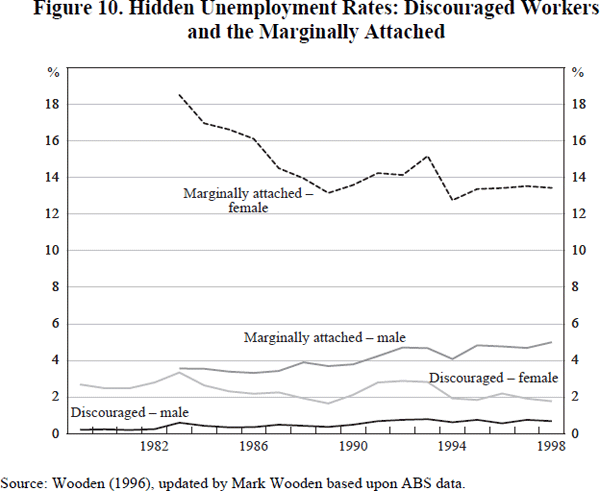
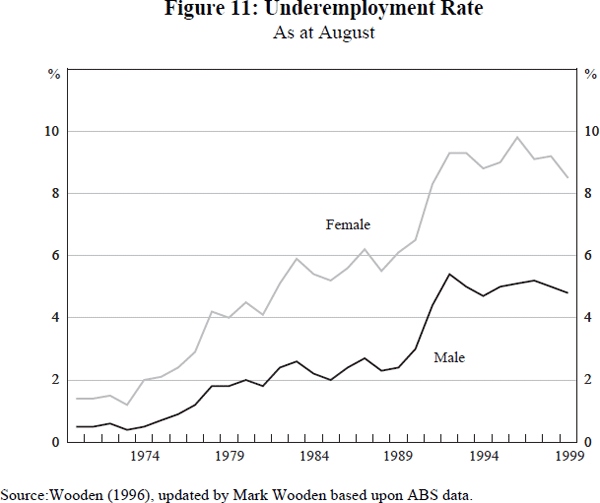
Furthermore, the trends in labour productivity and real wages were quite different in the two decades. In the 1980s labour productivity increased quite slowly. In the 1990s it increased faster. The contrast in trends in real wages was even more striking. In the 1980s, real wages declined steadily after the introduction of the Accord. In the 1990s, in an era when enterprise bargaining was becoming prevalent, real wages have grown quite strongly. Thus it appears that, possibly as a result of the enterprise bargaining era, employees have cashed in significantly on the increasing labour productivity (Figures 12 and 13).
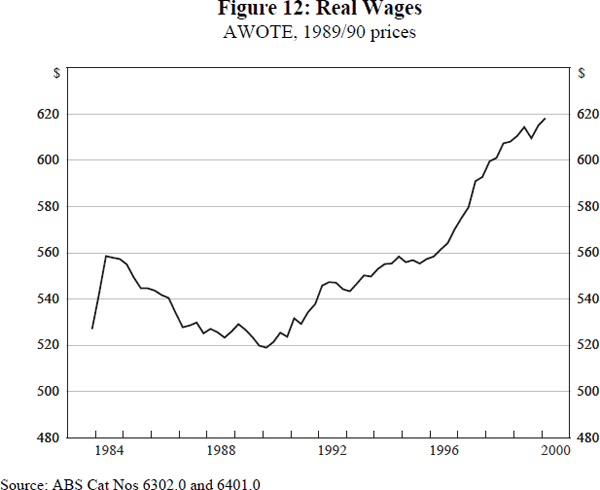
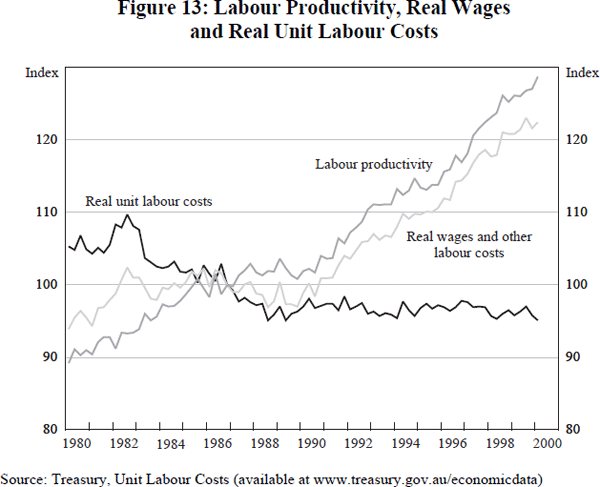
This has produced a different outcome with respect to real unit labour costs. While they have continued on a downward trend (Figure 13), it has been a much more modest downward trend than in the 1980s. This is likely to be part of the reason why employment growth has not been quite so strong as in the expansion in the 1980s.
3. Labour Market Institutions and Policies in the 1990s
3.1 Enterprise bargaining
The most dramatic change in the institutional environment in the 1990s has been the rise in the incidence of enterprise bargaining. Figure 14, taken from Wooden (2000c), shows how since enterprise agreements were introduced in the Federal system they have grown in importance dramatically in the 1990s. The current wage-agreement series shows the number of employees covered by current Federal enterprise agreements, as published quarterly by the Department of Employment, Workplace Relations and Small Business (DEWRSB). Wooden (2000c) points out that the DEWRSB series only includes current agreements and not all agreements in force. He has added to those covered by current agreements an estimate of the numbers covered by all agreements to produce the all agreements series in Figure 14.[8]
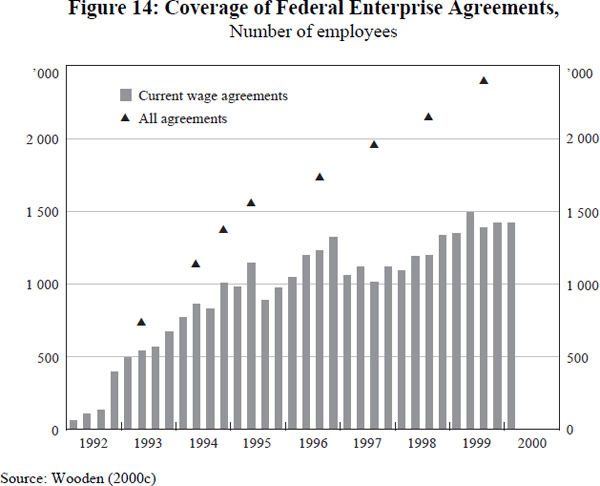
There has also been growth in enterprise agreements in the State jurisdictions and this has resulted in such wage setting being the dominant mode of wage setting. Table 2 presents estimates, obtained by a survey of firms conducted by DEWRSB, of the coverage of agreements as opposed to those whose wages are still set purely by awards.
| Type of wage-setting arrangement | Percentage of employees covered(a) |
|---|---|
| Registered collective agreements | 42 |
| Over-awards/unregistered agreements | 22 |
| Registered individual agreements/common law | 14 |
| Awards only | 22 |
|
(a) Only applies to workplaces with 5 or more employees and excludes agriculture. Source: Joint Governments' Submission (2000) |
|
3.2 The wages safety net
The strong growth of enterprise bargaining has curtailed the importance of the Industrial Relations Commission and its State counterparts. However, for the approximately 22 per cent of employees who have continued to rely on awards for their wages to increase, the decisions of the Industrial Relations Commission in its Safety Net Reviews have been important. These reviews have often been referred to as ‘Living Wage Cases’, a term coined by the ACTU. Their claims for increases in the wages safety net or ‘living wage claims’ retain a major role for the ACTU and the Industrial Relations Commission.
Interestingly, it can be seen from Figure 15 that the real value of minimum wages in Australia were on a downward trend through the 1980s, due first to the wages freeze, and then to the Accord. But this slowed down during the 1990s, once enterprise bargaining came into full swing and the Industrial Relations Commission became concerned about the safety net falling behind enterprise bargaining outcomes. Indeed the ‘living wage cases’ since 1996 have given a significant boost to real minimum wages.
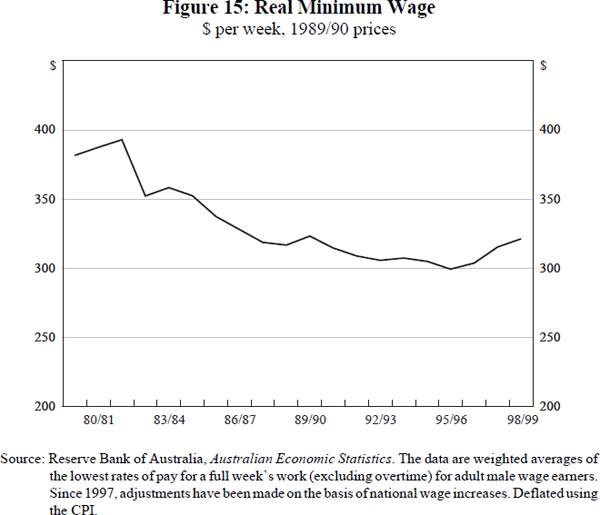
There remains a lively debate about the effect of minimum wages in Australia, with proponents of significant regular rises in minimum wages pointing especially to evidence from the US that minimum wage rises do not have an adverse effect on employment (Card and Krueger 1994, 1995). Those who see minimum wage rises as a bigger risk to employment point out that in the US the minimum wage is much lower relative to median earnings than in Australia, and that fewer workers are paid the minimum wage (see for example Dawkins and Gruen (1999) and the Joint Governments' Submission (2000)).
Table 3 presents evidence from Metcalf (1999) on the real value of the national minimum wage in each of nine countries, and its value relative to full-time median earnings. This shows that Australia is at the high end of the distribution as far as minimum wages are concerned.
| Country (year of introduction) | End 1997 NMW(a) in US$ using PPPs(b) | Mid 1997 NMW as % of full-time median earnings |
|---|---|---|
| Australia (1996, some form since 1907) | 6.65 | 54 |
| Belgium (1975) | 6.40 | 50 |
| Canada (Women (1918–30); Men (1930–59)) | 5.33 | 40 |
| France (1950, 1970 in current form) | 5.56 | 57 |
| Japan (1959, 1968 in current form) | 3.38 | 31 |
| Netherlands (1968) | 6.00 | 49 |
| Spain (1963, 1976 in current form) | 2.94 | 32 |
| United States (1938) | 5.15 | 38 |
| United Kingdom (1999) | 5.44 | 44 |
|
(a) National minimum wage Source: Reproduced from Metcalf (1999) |
||
Metcalf (1999), who has conducted a detailed study of the effects of minimum wages in the context of the setting of a minimum wage in the UK, has pointed out that modest increases in minimum wages when they are at very low levels do not tend to have adverse effects on employment, and may sometimes have positive effects. However, at higher levels increases in minimum wages can be expected to have significant adverse effects on employment. It seems that the setting of the minimum wage in the UK was strongly influenced by this observation and that we should be much more cautious about raising the much higher Federal minimum wage in Australia.
When it is added that the Federal minimum wage is only the bottom rung of a whole structure of minimum wages in Australia, this provides further reason to become nervous about the effect of raising them significantly, especially armed with the knowledge that international evidence suggests that the elasticity of demand for low-skilled labour tends to be higher than for others.
3.3 Labour market programs
As a result of the recession in the early 1990s, the Labor Government introduced its Working Nation policies, the major emphasis of which was labour market programs including wage subsidies. A target of a 5 per cent unemployment rate was set and significant progress was made in that direction in 1994[9] (but not in 1995). This was probably due more to the economic recovery than to the labour market programs, although there is some evidence that the labour market programs have had a significant effect on the incidence of long-term unemployment.[10]
These programs were nonetheless expensive and the newly elected Coalition Government, in cutting government spending, targeted labour market programs as an area to cut. Instead, they introduced Job Network, involving the ‘outsourcing’ of employment placement services to private as well as public providers. With funding attached to the contracts with the providers, this program aimed at creating a strong incentive for successful placement. This funding could be used partly for purposes like those of the previous labour market programs, but only if the providers considered it appropriate.
In addition to Job Network the Coalition Government later introduced the Work for the Dole Scheme, itself a kind of labour market program with some similarities to some of the community employment programs that had been operated in the 1980s and to some extent under Working Nation.
The rationale for the Work for the Dole Scheme, as espoused by the Coalition, is partly to provide useful experience and promote good work habits, but it is also seen as a way in which the unemployed can meet their ‘mutual obligation’ requirement associated with receiving income support. Indeed in the 1990s mutual obligation (referred to by the Labor Government under Working Nation as ‘reciprocal obligation’), has become a very important feature of employment policy.
3.4 Tax, social security and the labour market
There has been a growing awareness in the 1990s of the importance of the relationship between the labour market and the social security system. This has been a major motivation for the establishment of a review of the welfare system by the current Federal Government.
The interim report of the Reference Group on Welfare Reform[11] established in this process noted that although there has been incremental reform, the social support system has its origins ‘in a fundamentally different economic and social environment. It was designed during a time of low unemployment, generally of short duration, and when the most common [household] type was a couple with children and a principal male breadwinner. Social security was provided for a small minority of cases in which a family was unable to provide for itself, due to unemployment or severe disability, or where there was a sole parent. Such benefits were means-tested to ensure that support went to those with obvious needs.
‘The growth of unemployment, the rising trend of lone parenthood and an ageing population has made income support a less exceptional circumstance. These changes have resulted in a growing array of benefit types with associated payments and means-test… The increasing complexity of the system and [the associated] high effective marginal tax rates, along with the compartmentalisation of the system, and the rising numbers on income support, has led to the Reference Group's conclusion that the system needs fundamental reform’ (Reference Group On Welfare Reform 2000a, p 10).
The Reference Group argued that there were four particular shortcomings with the existing income support provisions and associated support services:
- The current rigid categorical array of pensions and allowances for people of workforce age is overly complex and relies heavily on presumptions about capacity for participation within particular groups of people rather than recognising the diversity of each individual's capacity and circumstances.
- Incentives for participation could be improved and some forms of work are not sufficiently rewarded.
- There is insufficient recognition of the many forms in which people make a contribution, including social participation.
- The service delivery arrangements and access to services are fragmented and not sufficiently focused on participation goals for all people of workforce age.
Figure 16 shows what has been happening, on average, to the relationship between unemployment benefits and the minimum wage over time. It is striking that in the 1980s this was on a strongly rising trend. However, it seems that this has changed in the 1990s, first with a slow-down in the growth, and more recently with a slight decline. This has been driven mainly by the fact that benefits were rising quite significantly in the 1980s but have slowed down in the 1990s (Figure 17). However, the ratio reached its highest point since 1976 in 1996, suggesting that there has perhaps been a progressive blunting of the incentive to work since the early 1980s that has only recently been halted.[12]
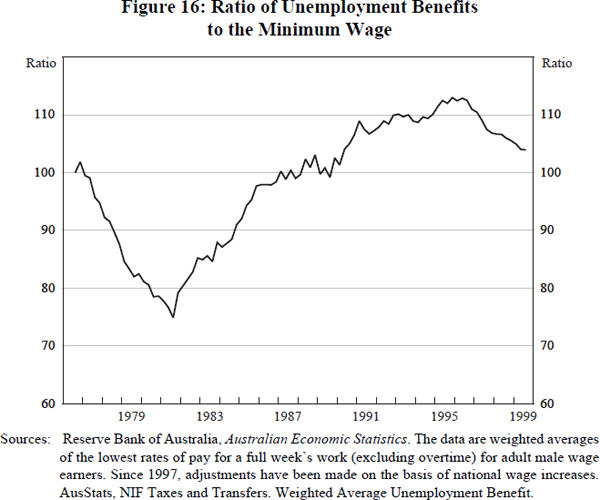
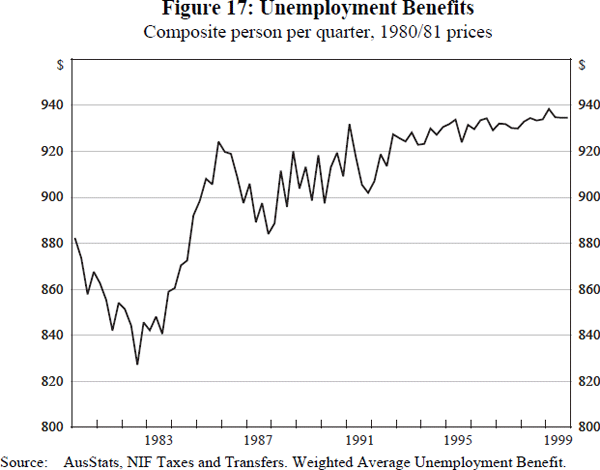
There has certainly been a growing awareness of work incentive issues and a growing interest in the idea that an important feature of policies aimed at raising employment could be to increase the incentive for people to move from welfare to work. In the 1990s this has resulted in an interest in the idea that people on low wages in households with low incomes might have their wages supplemented by income support payments.
4. The Drivers
Having reviewed the trends in labour market outcomes and in labour market policies and institutions, the focus in this section is on what has driven these trends. Important questions include for example, has it been the changes in policies and institutions that have driven the outcomes, or are they endogenous? Have there been more fundamental drivers that have driven outcomes, policies and institutions?
4.1 The business cycle
Clearly the business cycle has had a profound influence on labour market outcomes in the 1990s. The recession at the beginning of the nineties led to very high unemployment (about 11 per cent) and the subsequent long recovery has brought the unemployment rate down again to below 7 per cent. This is a good illustration of the argument that the worst thing that can happen as far as unemployment is concerned is a recession. Thus, if it is possible to prevent a recession, delay a recession, or reduce the severity of a recession, then the better the outlook for the unemployment rate.[13] Thus macroeconomic policy is of great importance as far as labour market outcomes are concerned. In observing the movement of aggregate employment and unemployment in the 1980s and 1990s, the business cycle appears to have been a major driver.
Having said that, it is a matter of concern that despite a long recovery period of high economic growth, we still have unemployment of about 6½ per cent. With inflation rising slightly and monetary policy having tightened somewhat, this is leading some commentators to suggest that perhaps we are close to the natural rate of unemployment or the NAIRU, and perhaps only major structural reform can reduce the NAIRU to 5 per cent or below. We will return to this issue in Section 4.5.
It should be added that when we look underneath the aggregate trends in employment and unemployment (for example at trends in part-time employment) and at trends in average and relative wages, the cycle does not appear to have much influence. There are clearly some secular trends tending to cause rising earnings inequality and also a strong growth in part-time and casual employment.
4.2 Technological change, trade and globalisation
4.2.1 Technological change and part-time employment
The most pronounced change in labour market outcomes over the last two decades has been the approximate doubling of the number of part-time employees, a substantial proportion of whom are casual workers. Part-time employment now represents over 20 per cent of employment. The major driver of this trend is thought to be technological change which has made part-time and especially casual employment, increasingly attractive to employers, especially in the service sector (Dawkins and Norris 1995). This trend, however, was made possible by the substantial growth in the labour force participation of women, for whom part-time/casual employment is often a very attractive proposition, as it is to many young people, particularly those in education.
It is also possible that one of the reasons why casual employment (which is mostly part-time) has been so successful is the flexibility it affords to employers under the industrial relations system, relative to permanent employment.
4.2.2 Trade and technology and the earnings distribution[14]
Trade effects and the Stolper-Samuelson theorem
Especially in the United States, but in many other OECD countries as well, there has been a widening of the earnings distribution over the last twenty-five years. One of the features of this in some countries (including the US) has been a widening of skill differentials.
There have been two main possible causes of this that have been put forward. One is the increase in the importance of international trade, often referred to as ‘globalisation’. Under one version of this explanation, consistent with the Stolper-Samuelson ‘wage equalisation’ theorem, an increase in trade tends to cause a reduction in wages of unskilled labour in countries with a comparative advantage in the production of skill-intensive commodities. This is because there is a shift in the demand for commodities with low-skill content towards those countries with a comparative advantage in low-skill intensive commodities. This in turn reduces the demand for low-skilled labour in the relatively high-skilled economies, and forces the low-skilled wages towards low-skilled wages in the less-skilled (less-developed) economies.
Under the Stolper-Samuelson theorem, relative producer prices change and also there is a second-round effect increasing the demand for low-skilled labour in high-skilled economies as a result of these changes in relative prices and wages.
Empirical evidence for these Stolper-Samuelson effects has been hard to find. Some studies have found changes in skill differentials, particularly in the US, consistent with the theorem, but less evidence of the producer price effects, and less evidence still of increasing demand for low-skilled, low-wage labour.[15]
If evidence of the Stolper-Samuelson effects have been hard to find in the US, they have been even harder to find in Australia, where there is a lack of evidence, even, of changes in skill differentials.
When considering what has happened to the overall distribution of earnings, at first sight it seems plausible that the same is true for Australia as the US. Table 1 provides evidence on the widening distribution of earnings presented in Norris and McLean (1999). It shows that over the last twenty-five years the earnings of the lowest decile and quartile of the earnings distribution have declined markedly relative to median earnings. Also, the earnings of the upper quartile and decile of the earnings distribution have risen markedly relative to median earnings. This is true for both males and females.
When examining the reasons for such a widening of the earnings distribution, however, Norris and McLean point out that to a large extent the explanation lies in the strong growth in employment of high-wage workers, rather than in changes in the relative wage of high-wage and low-wage workers. They reproduce evidence from the Economic Planning and Advisory Commission (EPAC 1996) as evidence of this (Table 4). It demonstrates that there was very strong growth in employment in high-wage and high-skill jobs between 1986 and 1995, but not in low-skill and low-wage jobs. Meanwhile there was no significant difference between the growth in wages of high-wage and low-wage employees.[16]
| Nominal wages 1986–1995 |
Employment 1986–1994 |
|
|---|---|---|
| By 1986 wage of occupation | ||
| High | 58 | 22 |
| Middle | 50 | 16 |
| Low | 57 | −4 |
| By skill level of occupation | ||
| High | 58 | 24 |
| Middle | 52 | 0 |
| Low | 55 | 2 |
|
Source: EPAC (1996) |
||
This is consistent with the evidence on occupational wage differentials uncovered by Fahrer and Pease (1994), who were specifically looking for evidence on Stolper-Samuelson effects in Australia. They found no evidence of a systematic widening of occupational wage differentials between 1987 and 1993. They focused on the wage differentials between unskilled machinists and high-skilled managers, administrators and professionals, which showed no obvious signs of an upward trend.
In view of the changes to the wage setting system since 1993, it might be expected that there has been such a widening since then. It seems plausible that with enterprise bargains and individual contracts providing for higher wage increases than awards, such occupational wage differentials may have widened. To test this, Dawkins and Kenyon (1999) obtained similar data from the ABS as those presented by Fahrer and Pease (1994), but updated to 1998. These data are presented in Table 5. Perhaps a little surprisingly, there is still no obvious sign of a widening of these occupational wage differentials, although this requires further research.
| Low-skilled occupation | Ratio of hourly wage to skilled hourly wage As at May |
||||||
|---|---|---|---|---|---|---|---|
| 1991 | 1992 | 1993 | 1994 | 1995 | 1996 | 1998 | |
| Machine operators | |||||||
| Food processing | 0.63 | 0.65 | 0.65 | 0.69 | 0.66 | 0.70 | na |
| Textile sewing | 0.55 | 0.54 | 0.53 | 0.53 | 0.52 | 0.52 | 0.49 |
| Shoemaking | 0.60 | 0.59 | na | 0.57 | 0.53 | 0.55 | 0.62 |
| Wood processing | 0.63 | 0.60 | 0.61 | 0.61 | 0.61 | 0.60 | 0.59 |
| Paper and paper products | 0.77 | 0.79 | 0.77 | 0.77 | 0.68 | 0.77 | 0.66 |
| Chemical production | 0.84 | 0.73 | 0.71 | 0.68 | 0.75 | 0.75 | 0.76 |
| Clay and stone processing | 0.68 | 0.62 | 0.61 | 0.64 | 0.66 | 0.60 | 0.56 |
| Basic metal product | 0.67 | 0.66 | 0.70 | 0.73 | 0.67 | 0.72 | na |
| Other metal products | 0.62 | 0.67 | 0.62 | 0.65 | 0.68 | 0.59 | na |
| Photographic products | 0.62 | 0.66 | 0.78 | 0.60 | 0.64 | 0.63 | 0.55 |
| Plastics production | 0.61 | 0.62 | 0.66 | 0.66 | 0.63 | 0.72 | 0.62 |
|
Source: Dawkins and Kenyon (1999). Constructed from ABS data. |
|||||||
The Industry Commission's study of the trade liberalisation and earnings distribution (Murtough, Pearson and Wreford 1998) also found no general evidence of the changes in wage relativities (or in relative producer prices) that would be predicted in accordance with Stolper-Samuelson effects.
The evidence appears to be that unemployment has increased among workers with less education, for new entrants to the labour market (youth) and for older males displaced from tariff-adjusting industries. Some economists argue that wage rigidity, due to institutional factors, has prevented full wage adjustment to occur, thus shifting the burden to unemployment (see Fahrer and Pease (1994)).
It is certainly the case that unemployment is highest among the low-skilled, although Vickery (1999) has not found evidence that the incidence of unemployment amongst the low-skilled has risen any faster than for the higher-skilled. This is because there has been a shift in the supply of labour towards higher-skill just as there has been a shift in demand.
Technological change
The other main explanation that has been put forward for the widening distribution of earnings, is that of ‘skill-biased’ technological change. Under this explanation, technological change (e.g. computerisation and digitisation) has tended to be complementary to high-skilled labour but a substitute for low-skilled labour, thus leading to growth in demand for high-skilled labour and a decline in demand for low-skilled labour. This explanation is more consistent (than the Stolper-Samuelson theorem) with the strong growth in demand for high-skilled labour driving the widening of the earnings distribution.
Further shift-share analysis by Fahrer and Pease (1994), decomposing changes in employment by industry sector into the respective contributions of trade and productivity effects (and where the trade effects are further decomposed into imports from ‘low-wage countries’ and ‘high-wage countries’), suggests that productivity effects have been the dominant force behind the decline in manufacturing employment between 1981/82 and 1991/92, except for one industry – clothing, textiles and footwear. The latter industry is the only one that tends to fit the Stolper-Samuelson stylised facts. Fahrer and Pease (1994) interpreted their results as support for an explanation for changed employment patterns based on skill-biased technological change in the presence of wage rigidities.
Murtough et al (1998) used the Monash Model to analyse the effects of trade liberalisation versus effects of technology. Note that in the Monash Model, rigid wage relativities between occupations are assumed, which appears to be consistent with the evidence presented above.
Their results indicated that between 1986/87 and 1993/94, the number of hours worked in manufacturing had fallen by 12.7 per cent of total Australian labour supply, and that employment had not grown over that period. Of this about one-tenth, i.e. 1.4 per cent, of the decline in hours worked was estimated to have been caused by changes in industry assistance (including tariffs). About a quarter, i.e. 3.2 per cent, was estimated to have resulted from technological change across the economy that reduced the use of manufactured inputs and labour per unit of output. About one-third, i.e. 4.4 per cent, of the estimated employment decline was linked to shifts in preferences between imports and domestic products not attributable to changes in relative prices. The authors suggest that ‘it is possible that some of this change was associated with the removal of quantitative import restrictions’ (Murtough et al 1998, p xii).
Tyers and Yang (1997) used a global computable general equilibrium model to examine the effect of trade versus technology on output and factor rewards. One of the three regions of older industrialised economies was Australasia. The findings support the view that, as in the US, technological change has been the main driving force in the widening of factor rewards in Australia, benefiting professional labour most, production labour next, and farm labour least. Indeed, farm labour in Australia is found to have been affected negatively.
The inter-relationship between globalisation and technological change
While the international literature has favoured the technological change explanation of widening earnings dispersion over the globalisation explanation, some authors have pointed out that there is a strong link between technological change and globalisation. In particular, Feenstra (1998) has argued that the ‘disintegration’ of production in the global economy has been a major driver of skill-biased technical change, favouring high-skilled labour in high-wage economies and low-skilled labour in low-wage economies, with the associated intra-firm trade not showing up in the trade in final goods and services.
4.3 Wages and the wage-setting system
4.3.1 Wages and employment
One of the outcomes of the 1980s was a fairly widespread consensus amongst Australian labour economists that the decline in real wages under the Accord, and the associated decline in real unit labour costs was a major determinant of the strong employment growth in that period. As we saw in Figures 12 and 13, real wages have grown quite strongly in the 1990s. The effect on real unit labour costs has been ameliorated by a rise in labour productivity. However, part of the explanation of why employment has not grown as strongly as it did under Accord period, is arguably, that real unit labour costs have not been restrained as much.
Just as the Accord is generally given credit for the paths of real wages and employment in the 1980s, have changes in the wage-setting system driven the real wage growth and productivity growth in the 1990s?
4.3.2 The wage-setting system
In the 1990s the wage-setting system has become more decentralised. Enterprise bargaining has become the dominant mode of wage setting rather than arbitrated awards. This was discussed in Section 3.1.
It is very difficult to determine the effects of changes in the wage-setting system on labour market outcomes. This is because of the difficulty of establishing the counterfactual, i.e. what would have been the outcome had the wage-setting system not moved in favour of enterprise bargaining. Further it could be argued that even trying to establish the counterfactual could be a misconceived idea because the move to more decentralised wage setting could be the outcome of other changes, such as deregulation of product markets, liberalisation of trade, technological change and globalisation, rather than an exogenous policy development.
Despite that, let us consider whether the change in wage-setting may have impacted on wages, productivity, employment and unemployment.
One of the motivations for moving to more decentralised wage bargaining was certainly to raise labour productivity and that has been observed. The fact that a high proportion of the benefits of labour productivity growth has been taken in the form of higher real wages is consistent with the story that enterprise bargaining has created the incentive for labour to increase its ‘effort’ in order to gain higher wages.
Figure 18 (grey observations) shows how labour productivity growth appeared to take off around 1994 soon after enterprise bargaining began to take hold (Parham 1999), providing circumstantial evidence that enterprise bargaining may have been a major cause. However, it is apparent that labour productivity rose quite sharply after the recession in the early 1980s, suggesting that there may have been a post-recession effect in operation. It is also noticeable that in the 1980s labour productivity was fairly sluggish, arguably influenced partly by the wage restraint under the Accord which tended to cause rising labour intensity. Thus in the post-Accord period capital intensification may have been a major part of the story, reinforced by the effects of a sustained period of microeconomic reform. That is not to deny that enterprise bargaining may also be part of the story.
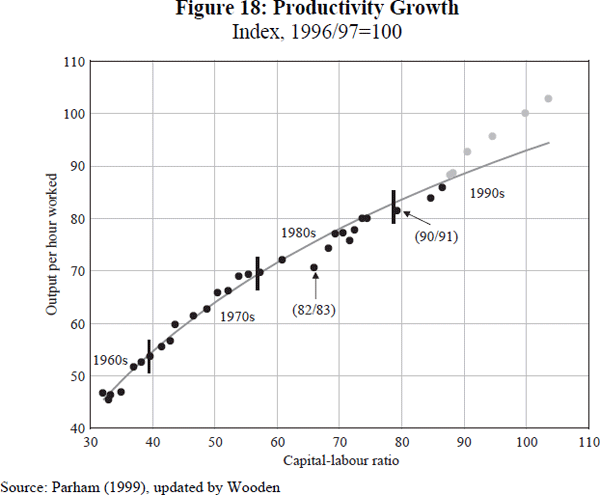
This may be a surprise to some who might have expected a more decentralised wage-setting system with declining union density[17] to be associated with lower wage outcomes, higher employment growth and low productivity growth. This is the interpretation that is often put on the New Zealand experience of labour market reform.
It does seem that Australia's enterprise bargaining reforms have been quite different from the New Zealand case.
Research by Wooden (2000a) has also found that the union wage mark-up appears to have risen significantly along with enterprise bargaining, albeit with a much lower level of union density than a decade earlier.
The idea that enterprise bargaining has supported strong growth in real wages and increased union mark-ups is also consistent with a story that most of the benefits of rising productivity growth have gone in the form of higher wages. While there has been reasonably strong employment growth in the recovery period after the last recession, it was not quite as strong as in the 1980s when real wages were restrained, and real unit labour costs declined somewhat more than they did in the 1990s.
4.4 The social security system?
In the 1990s there has been a recognition that the increasing complexity of the social security system and the associated high effective marginal tax rates for many low-income families may have been causing serious disincentive problems in the labour market, and may be one of the factors causing the problem of workless families.[18] Both the Coalition Government and the Opposition focused on this issue during the tax debate prior to the 1998 election. Changes to family payments in the tax package have helped reduce the effective marginal tax rates for many low to middle income families with children. But there are reasons to believe that there may be much more left to do to increase incentives to work, as part of the reform to the welfare system aimed at reducing the incidence of workless families and households and the extent of heavy reliance on income support (Reference Group on Welfare Reform 2000a).
4.5 The NAIRU?
Over the last twenty years it has been conventional to assume that there is a non-accelerating inflation rate of unemployment (NAIRU). Thus if we seek, through macroeconomic policy, to get unemployment below that level, inflation will rise. There has been a recognition that the NAIRU can change by two types of mechanisms. First, structural change in the economy (e.g. labour market reform) can reduce the level of unemployment that the economy can sustain. Second, the NAIRU may move up or down in response to changes in the actual rate, by a process of hysteresis.
Under the first mechanism, microeconomic reform is emphasised as necessary to make a lasting impact on unemployment. Under the second mechanism, demand management can itself help to get the NAIRU down.
There is a range of estimates of the NAIRU, each tending to have quite high standard errors. If there is a conventional wisdom about it in Australia, it is probably that it has been around 6 to 7 per cent over the last twenty years (e.g. Debelle and Vickery 1998; Gruen, Pagan, and Thompson 1999). This kind of assumption is embodied in the main structural models of the macroeconomy in Australia, such as the Treasury Macroeconomic (TRYM) Model, the Murphy Model and the Access Model. However, some studies have estimated it as being much higher (e.g. Crosby and Olekalns 1998) and others have been increasingly questioning the robustness of the concept (a good discussion of the literature can be found in Borland and McDonald (forthcoming)). This is partly because of the wide range of estimates and their high standard errors. It is also because inspection of the data shows that the Phillips Curve relationship between inflation and unemployment has tended to be very ‘flat’, i.e. there has been a wide range of unemployment rates observed over a small range of inflation levels.
If we accept the conventional wisdom, however, the NAIRU has not been a binding constraint on the labour market in the 1990s, and for most of the time unemployment has been above the NAIRU. The challenge has thus been to get unemployment down to the NAIRU. The long expansion since the last recession has now brought the unemployment rate down to around the NAIRU. Acceptance of this position suggests that getting unemployment down much further without causing rising inflation is a major challenge that may require structural reform of the labour market.
In the author's view, one of the reasons why the NAIRU is a ‘rubbery’ concept, is that the unemployment rate is not necessarily a very precise measure of the tightness of the labour market. Variations in the level of hidden unemployment and underemployment, and in the amount of long-term unemployment mean that the tightness of the labour market can vary independently of the unemployment rate.[19] This might be caused by hysteresis or by other forces present in the labour market such as changes in the skill composition of the labour force or changes in the demand for different types of skills. Further, the Phillips Curve framework may not take sufficient account of factors other than the labour market in generating inflationary pressure.
Having said that, there would be few economists who would deny that as the economy gets closer to full capacity utilisation, so inflationary tendencies tend to emerge, and inflation has the potential to feed on itself through a cost-price spiral, unless policies are implemented to dampen the process. Such policies will tend to slow the economy and raise the level of unemployment.
Thus as we enter the 2000s, for example, after eight years of continued economic expansion and employment growth, we are seeing evidence of inflation rising and threatening to go above the Reserve Bank's target range. This has led the Reserve Bank to raise interest rates, and to take a more neutral monetary policy stance than the expansionary stance adopted during the Asian crisis.
If growth continues strongly, the Bank may have to raise interest rates further to dampen inflation. The question remains whether this will necessitate preventing the unemployment rate from declining towards 5 per cent. We are thus entering a period that may prove to be a strong test of how useful the concept of the NAIRU is. Having said that, its defenders might argue that what is really being tested is whether the NAIRU has actually fallen.
5. Unresolved Issues
This paper began with the observation that while there has been a shift in the 1990s towards a stronger market orientation in Australian labour market policy, the debate about the proper role of government in influencing labour market outcomes remains an open one.
It was noted that in some ways labour market outcomes in the 1990s have been strong, especially when focussing on labour productivity growth and real wage increases for the employed. The long expansion since the last recession has also enabled a long period of good employment growth and a substantial reduction in unemployment after the high level reached in the recession at the beginning of the decade.
On a less positive note, unemployment remains at about 6½ per cent after a very long expansion, and there remains a high incidence of ‘jobless families’. Further, the labour force participation rate has not grown much in this long expansion period. This is not necessarily a bad thing in itself, especially if those not participating are ‘optimising’. However, estimates of underemployment and the number of discouraged workers, especially females, remain high, suggesting that if labour demand growth was stronger the participation rate would be higher. And the number of jobless families remains high.
There has also been a widening distribution of earnings, although research by Johnson, Manning and Hellwig (1995) and by Harding (1997) suggests that government social policy has been effective in avoiding a widening distribution of income (at least up to the end of the available income distribution data in 1996). There have been growing concerns, however, that this social policy has been associated with growing welfare dependency and weakened incentives to work.
As we move into the 21st century we face a number of major questions and challenges. Can the strong growth in labour productivity be maintained? Can employment growth continue and enable substantial further reductions in unemployment and hidden unemployment? Can we significantly reduce the number of jobless families? Will the rising earnings inequality continue? Indeed, is rising earnings inequality necessary if we are to substantially reduce unemployment? If so, can we pursue a social policy that continues to resist rising income inequality while sharpening incentives for people to move from welfare to work?
If we are going to be successful in achieving these various objectives, will it be with a more market-oriented approach or with a more interventionist/regulated approach to the labour market?
In what follows, four different views are presented about the possible way forward.
5.1 View One: there is not much more to do, with a few more years of growth we will be at full employment without any more labour market reform.
Some economists[20] have argued that continued strong growth should be able to get the unemployment rate down to 5 per cent or below, and that the emphasis of government policy should be to maintain strong economic growth through an appropriately expansionary macroeconomic policy. Indeed, under this view, a significant worry about the labour market over the medium term is that the ageing workforce and declining fertility may lead us soon to a problem of over-employment rather than unemployment, and that an important policy focus will be to find more labour resources through increased immigration, later retirement etc.
If reforms are needed, they might be to help unleash a more effective labour supply. Thus welfare-to-work policies aimed especially at increasing job readiness and possibly at work incentives[21] could play an important role to help employment growth to continue.
Under this view, the concept of the NAIRU is not seen as a serious constraint. A concept that might be seen as more useful under this view is that of the stable inflation rate of growth or SIRG put forward by Dungey and Pitchford (1998). They estimated the SIRG as being about 4.4 per cent per annum. On this basis they argued that it may be possible to get unemployment down to 5 or 6 per cent over the four years following 1998, without causing rising inflation.
This general argument is plausible, especially as unemployment has already come down to 6.6 per cent and continued strong growth is being forecast by a number of economic forecasters. However, it represents a high-risk approach to policy to rely solely on economic growth to provide a long-run solution to the unemployment problem.
First, it should be noted that in Dungey and Pitchford's model the ability to achieve unemployment reduction depends partly on what happens to wage costs. Thus there are good reasons to focus on the way in which wages are set as an important determinant of unemployment.
Second, it is striking that although we are now in the eighth year of strong economic growth, the unemployment rate is still at around 6½ per cent and the level of hidden unemployment and underemployment remains quite high. There would appear to be a significant risk that the current expansion could end before unemployment, hidden unemployment and underemployment reach a level that could be approximately described as full employment. Even if unemployment came down as low as 5 or 5½ per cent before rising again, hidden unemployment and underemployment may prove still to be higher than desirable, and arguably even 5 per cent is too high for a minimum level of unemployment. This would suggest that there may need to be some structural reform to the labour market for us to achieve full employment.
5.2 View Two: labour market reform has failed – we need to undo the reform process.
If View One is a little optimistic, View Two represents the strongest degree of dissatisfaction with trends in government policy over the 1990s.
Under this view, a major focus is on the widening distribution of earnings, and the level of unemployment would also be a major concern. Decentralising and deregulating wage determination, it is argued, have been a major driver of the widening earnings distribution, and the benefits of strong economic growth have been unevenly distributed with the major benefits going to high-income earners. While unemployment has come down, it is still quite high and what is needed is a much more interventionist labour market policy. One version of such a policy would be associated with coordinated wage setting while restraining aggregate wage growth. Another might be that what is more important is public sector job creation. A proponent of this view might also question the case for free trade and see trade liberalisation as one of the causes of the perceived problems.
These views do not have many supporters in mainstream policy discussion, as the move towards a more open and market-oriented economy has brought with it substantial productivity improvement[22], and there are signs that unemployment may be falling towards more acceptable levels. Changes in labour market policy are to a significant extent endogenous, and seeking to make a major reversal of this trend is generally viewed as unrealistic and highly risky.
A milder variant of this argument might be that rather than abandoning the current policy thrust toward a freer labour market and market-oriented solutions, we need to increase the emphasis a little on government intervention, perhaps reasserting the powers of the Industrial Relations Commission somewhat, and spending more on labour market programs.
5.3 View Three: only a free market solution will work – we must wind back the role of government.
Under this view, the movement to a free-market solution has been in the right direction, but the job is incomplete. The reason why unemployment remains unacceptably high and welfare dependency a major problem relates to remaining market impediments. These include high minimum wages, which are pricing low-skilled labour out of the labour market and high welfare benefits that lead to welfare dependency. Under this view what is needed is a more complete deregulation of wage setting, by removing the wages safety net, and substantial cuts in welfare benefits. This would allow the forces of supply and demand to work in the labour market to produce full employment and reinforce the incentive for people to move onward and upward through the labour market.
While this is a plausible view, the idea of cutting unemployment benefits is not a realistic proposition. It would carry with it the prospect of too many losers, especially in the short run. Many who are vulnerable in society would be forced into poverty.
5.4 View Four: we need something like the ‘five economists plan’: more labour market reform combined with the use of tax and social security to address distributional concerns.
Under this argument, View One is risky and may be too optimistic for reasons outlined in the discussion of that view above. View Two is not seen as a viable option, also for the reasons outlined above. In theory, View Three could result in full employment, but, as suggested above, would carry with it the prospect of too many big losers who would be forced into poverty, at least in the short run.
Unemployment and hidden unemployment, however, are seen as unacceptably high, and still in need of major attention, beyond hoping that continued macroeconomic expansion and avoiding recessions will deliver full employment. (Nonetheless seeking to avoid recessions is seen as a major plank of economic policy, which makes the steadiness of monetary and fiscal policy a very important ingredient.)
There is strong evidence that apart from the rate of output growth affecting employment positively, the other major determinant of employment growth is the growth of real wages (with a negative sign). Under this view, a policy that can have an irreversible dampening effect on real wage growth (without a commensurate reduction in productivity growth) would enable the economy to achieve a level of unemployment and hidden unemployment that would be much closer to full employment than looks likely otherwise.
Further, given that the labour market has been moving against unskilled labour and that unemployment and especially long-term unemployment is concentrated among the low-skilled, it would be an advantage if this wage restraint applied primarily to workers with relatively low wages. This proposition is reinforced by the observation that international evidence reveals that the elasticity of labour demand is higher for low-skilled labour than for high-skilled labour. The one policy option that appears to be available to apply wage restraint especially to low-wage workers is to hold back the growth in award wages.
There are two major concerns about a policy aimed at restraining wages growth especially of low-skilled workers. First, it leads to concerns about wage inequality (and its possible implications for income inequality).[23] Second, it needs to be noted that if low wages are restrained and unemployment benefits continue to rise in line with CPI, this raises the replacement ratio and reduces work incentives. This would make it very hard to convert the increased labour demand for low-wage employees into higher employment.
Thus it becomes very important to address this interface between the wage system and the social security system. Cutting unemployment benefits is rejected on equity grounds. This results in the need to supplement the income of low-wage earners (especially those in low-income families), through mechanisms such as a negative income tax, earned income tax credit, or through some other form of in-work benefit paid either through the tax or the transfer system. This is also the mechanism that should be used to deal with equity concerns that arise from the wage restraint of low wages.
The distributional effect of such a policy tends to be in favour of families with the low to middle incomes – families in the second, third and fourth deciles of the distribution of family income (Keating and Lambert 1998) – rather than families in the bottom decile, who are typically outside of paid employment. The benefit to some of those in the bottom decile would accrue if the policy package resulted in employment gains to jobless families.
Further, given the relatively high effective marginal tax rates that apply to low wage earners in low-income families, a policy of this kind would increase work incentives more easily than can be achieved through wage rises.
Other policies to help improve the job readiness and work incentives of those on social security benefits, in the form of job search assistance, training etc, are important complements to this policy.
It is also considered that in the long run, education and training policy is very important in seeking to maintain full employment without allowing the real wages of large numbers of workers to continue falling.
The author favours this approach.
6. Conclusions
Aggregate unemployment followed remarkably similar paths in the 1990s and the 1980s (with some differences that have been discussed) and the widening distribution of earnings and growth of part-time and casual employment has continued. The trends in employment and participation rates that produced these time patterns in unemployment, however, were quite different, with the recovery in the 1990s involving both slower employment growth and weaker growth in the participation rate. The recovery, however, has lasted longer.
The paths of productivity and wages have been very different in the 1990s compared with the 1980s. The differences appear to be explained by a combination of the effects of trade liberalisation and microeconomic reforms in general, as well as technological change and labour market reform. As yet, is it hard to place magnitudes on the effects of the different factors, which are anyway strongly interrelated.
Labour market policy has also been very different in the 1990s from the 1980s. In his paper on the labour market in the 1980s, Chapman (1990) noted the success of the Accord in restraining wage growth and in promoting employment growth. He quoted Calmfors and Driffill (1988), quite rightly, as providing a theoretical basis with some empirical support, for using wage coordination through a macroeconomic income policy to promote the employment prospects of the ‘outsiders’, who might be losers in a less coordinated wage setting system, where union power remains substantial. Chapman (1990) also noted however, that there were pressures to increase the role of enterprise bargaining and that it was a challenge for such enterprise bargaining to be accommodated into the Accord.
As it turned out, the 1990s have brought with it a dramatic move towards more decentralised wage setting and away from Accord style arrangements.
Under the Calmfors and Driffill (1988) view, prior to the Accord, Australia had been about halfway between the two better alternatives of highly centralised wage determination or highly decentralised wage determination. The Accord moved Australia towards the centralised end, and the predicted employment benefits materialised. In the 1990s however, Australia has moved towards the other end of the spectrum. While the employment growth has not been as dramatic as it was under the Accord, it has nonetheless been steady and no one is currently arguing for a return to the Accord end of the spectrum. Arguably, the Opposition may want Australia to move back towards the middle of the range, which may provide a test of the Calmfors and Driffill hypothesis that the middle of the range is the worst place to be. The Government on the other hand appears to want to keep the move towards decentralisation going, further testing the idea of Calmfors and Driffill that moving more towards decentralisation can confer additional benefits.
Looking to the future, the level of unemployment, hidden unemployment and underemployment that exists after eight years of sustained strong growth remains a major concern, as does the incidence of jobless families. It has been argued in this paper that we should not be too complacent about labour market policy in this environment. Continued growth, and as far as possible, avoiding a recession should be a major policy goal. At the same time, we should keep searching for structural change in the labour market to make a more permanent dent in the level of unemployment and joblessness.
It has been argued that an important ingredient in this will be welfare reform as well as increased emphasis on education and training. Alongside this however, the case for restraining wages (especially of low-skilled workers) by holding down the wages safety net has been canvassed, with a suggestion that equity concerns are better met through the tax and social security system, which could be used to boost the incomes of low-wage earners in low-income households and to simultaneously increase work incentives.
This broad approach to policy has been compared with three other broadly defined approaches that might be put forward. It has been argued that there are arguments that tend to cast doubt on the case for other approaches and the likelihood that they could prevail. The other most likely approach is one that aims to produce full employment without any further major structural reform of the labour market (although it could involve small changes to wage setting arrangements[24], and probably some movement on welfare reform). What happens to unemployment in the next two years could be a major factor in determining the chosen path. If we get down to a 5 per cent unemployment rate without increasing inflation above 3 per cent, the case for further significant structural change in wage setting arrangements may not prevail, at least for the time being. The discussion in this paper suggests, however, that the case will probably still remain.
Footnotes
Thanks to Rachel Derham for her research assistance, to Beth Webster and Mark Wooden for providing some of the data used, and to Ross Garnaut, David Gruen and Mark Wooden for comments on an earlier draft. [1]
These have sometimes involved larger increases in the minimum wages at the bottom, and smaller increases in minimum wages of higher-classified workers. [2]
The concept of ‘globalisation’ will be discussed later in the paper. [3]
We will see later that there is some doubt about the role of globalisation in affecting the distribution of earnings. [4]
Dawkins et al (1998). [5]
Annual working age population growth in the 1990s was 1.4 per cent, down from 2.0 per cent in the 1980s. [6]
Debelle and Swann (1998) have shown that male unemployment showed a particularly weak response to the recovery in the 1990s. This is consistent with the observation that it is female participation that has been relatively sluggish compared with the 1980s. [7]
In many cases formal agreements are not renewed. [8]
There was also a substantial reduction in unemployment in 1993 due to the pick-up in the economy, while Working Nation was being devised. [9]
See for example Stromback, Dockery and Ying (1999). [10]
The author is a member of the Reference Group. [11]
This provides a broad approximation to the trends in replacement rates on average across different household types. It does not, however, attempt to deduct taxes or add family payments to the minimum wage calculation. For a more detailed discussion and estimates of trends in replacement rates for different family types see Reference Group on Welfare Reform (2000a). This indicates that replacement rates for families with children (which are the highest) rose modestly in the 1980s due largely to increases in assistance to those who were renting privately. They rose a little more for families without children (to become just behind those for families with children) and more again for singles without children (albeit from a low level). It is also confirmed that there have been modest reductions in the 1990s except for singles. [12]
This observation is also very pertinent to the incidence of long-term unemployment (see Chapman and Kapuscinski (2000)). [13]
This section draws on Dawkins and Kenyon (1999). [14]
It is perhaps unsurprising that the second-round effects on the demand for low-skilled labour have been hard to find because they might be swamped by the first-round effects. [15]
It should be added, however, that there has been a widening of intra-occupational differentials as against inter-occupation differentials, though this is not particularly associated with Stolper-Samuelson effects either. [16]
Declining unionisation has been another significant feature of the 1980s and 1990s. Union density reduced from about 48 per cent to 28 per cent between 1982 and 1998, based on an ABS survey of trade union membership, and from about 54 per cent in 1982 to 35 per cent in 1996, based on trade union statistics (Wooden 2000b, p 11). [17]
There is very little empirical evidence in Australia about labour supply responses to the effect of tax and social security arrangements. For this reason the Melbourne Institute has been building the Melbourne Institute Tax and Transfer Simulator, incorporating econometric estimates of labour supply behaviour, which will shed more light on this issue in due course. [18]
There have been various attempts to incorporate other measures of labour market tightness in a Phillips Curve framework (e.g. Gregory 1986; Dawkins and Wooden 1985). [19]
Edwards (1999) espoused this view. [20]
Under this view it might be argued that in a strong labour market rising wages (including minimum wages) could help to sharpen work incentives without much policy intervention required. [21]
We have also seen that, anyway, there is considerable doubt surrounding the hypothesis that increasing trade openness, in itself, leads to a wider earnings dispersion. [22]
These concerns are often exaggerated because there is not a tight relationship between the earnings distribution of individuals and the distribution of household income. Richardson and Harding (1998) have shown for example that people earning low wages or minimum wages are well spread around the distribution of family income. [23]
This could involve some further degree of reduction in the importance of the Industrial Relations Commission, or some small increases, depending probably upon the outcome of the next Federal election. [24]
References
Borland J and I McDonald (forthcoming), ‘What do Existing Models Tell Us: Labour Market Models’, in Unemployment in Australia: Economic Analysis Policy Modelling: A Review of the Literature, Melbourne Institute of Applied Economic and Social Research, University of Melbourne, Paper No 1.
Calmfors L and J Driffill (1988), ‘Centralization of Wage Bargaining’, Economic Policy, 6, pp 14–61.
Card D and AB Krueger (1994), ‘Minimum Wages and Employment: A Case Study of the Fast-food Industry in New Jersey and Pennsylvania’, American Economic Review, 84(4), pp 772–793.
Card D and AB Krueger (1995), Myth and Measurement: The New Economics of the Minimum Wage, Princeton University Press, Princeton.
Chapman B (1990), ‘The Labour Market’, in SA Grenville (ed), The Australian Macro-Economy in the 1980s, Proceedings of a Conference, Reserve Bank of Australia, Sydney, pp 7–65.
Chapman B and C Kapuscinski (2000), ‘Avoiding Recessions and Australian Long-term Unemployment’, Centre for Economic Policy Research, Research School of Social Sciences, Australian National University, mimeo.
Crosby M and N Olekalns (1998), ‘Inflation, Unemployment and the NAIRU in Australia’, The Australian Economic Review, 31(2), pp 117–129.
Dawkins PJ (1996), ‘The Distribution of Work in Australia’, Economic Record, 72(218), pp 272–286.
Dawkins PJ (1998), ‘Solutions to Unemployment and Avoiding the “Diabolical Trade-off”: A Discussion’, in G Debelle and J Borland (eds), Unemployment and the Labour Market, Proceedings of a Conference, Reserve Bank of Australia and Centre for Economic Policy Research, ANU, Sydney, pp 309–328.
Dawkins PJ (1999), ‘A Plan to Cut Unemployment in Australia: An Elaboration on the “Five Economists” Letter to the Prime Minister, 28th October 1998’, Mercer-Melbourne Institute Quarterly Bulletin of Economic Trends, 1.99, pp 48–59.
Dawkins PJ and J Freebairn (1997), ‘Towards Full Employment’, The Australian Economic Review, 30 (4), pp 405–417.
Dawkins PJ, J Freebairn, R Garnaut, M Keating and C Richardson (1998), ‘Dear John, How to Create More Jobs’, The Australian, October 28.
Dawkins PJ and N Gruen (1999), ‘The BCA's Wage-tax Trade-off Proposal: On Reflection’, BCA Papers, 1(2), pp 88–97.
Dawkins PJ and P Kenyon (1999), ‘Globalisation and the Labour Market’, 28th Annual Conference of Economists, 27–30 September.
Dawkins PJ and K Norris (1995), ‘The Growth of Part-time Employment in Australia and the United Kingdom, 1978–93’, Labour Economics and Productivity, 7(1), pp 1–27.
Dawkins PJ and M Wooden (1985), ‘Labour Utilization and Wage Inflation in Australia: An Empirical Examination’, Economic Record, Supplement, 61, pp 516–521.
Debelle G and T Swann (1998), ‘Stylised Facts of the Australian Labour Market’, Reserve Bank of Australia Research Discussion Paper No 9804.
Debelle G and J Vickery (1998), ‘The Macroeconomics of Australian Unemployment’, in G Debelle and J Borland (eds), Unemployment and the Australian Labour Market, Proceedings of a Conference, Reserve Bank of Australia and Centre for Economic Policy Research, ANU, Sydney, pp 235–265.
Dungey M and J Pitchford (1998), ‘Prospects for Output and Employment Growth with Steady Inflation’, in G Debelle and J Borland (eds), Unemployment and the Australian Labour Market, Proceedings of a Conference, Reserve Bank of Australia and Centre for Economic Policy Research, ANU, Sydney, pp 208–234.
Economic Planning and Advisory Commission (EPAC) (1996), Future Labour Market Issues for Australia, EPAC Paper No 12, Australian Government Publishing Service, Canberra.
Edwards J (1999), ‘Let Growth Solve Our Unemployment’, The Australian Financial Review, March 8, p 17.
Fahrer J and A Pease (1994). ‘International Trade and the Australian Labour Market,’ in P Lowe and J Dwyer (eds), International Integration of the Australian Economy, Proceedings of a Conference, Reserve Bank of Australia, Sydney, pp 177–224.
Feenstra RC (1998), ‘Integration of Trade and Disintegration of Production in the Global Economy’, Journal of Economic Perspectives, 12(4), pp 31–50.
Garnaut R (1998), ‘Time to End Unemployment’, Mercer-Melbourne Institute Quarterly Bulletin of Economic Trends, 1.98, pp 55–62.
Gregory RG (1986), ‘Wages, Policy and Unemployment in Australia’, Economica, Supplement, 53, pp S53–S74.
Gregory RG and B Hunter (1995), ‘The Macro Economy and the Growth of Ghettos and Urban Poverty in Australia’, Centre for Policy Research Discussion Paper No 325, Australian National University, Canberra.
Gruen D, A Pagan and C Thompson (1999), ‘The Phillips Curve in Australia’, Journal of Monetary Economics, 44 (2), pp 235–258.
Harding, A (1997), ‘The Suffering Middle: Trends in Income Inequality in Australia, 1982 to 1993–94, The Australian Economic Review, 30(4), pp 341–358.
Johnson D, I Manning and O Hellwig (1995), Trends in the Distribution of Cash Income and Non-cash Benefits, Report to the Department of Prime Minister and Cabinet, Australian Government Publishing Service, Canberra.
Joint Governments' Submission (2000), The 1999–2000 Safety Net Review Case, Submission placed before the Australian Industrial Relations Commission, Canberra.
Keating M (2000), ‘Realising People's Potential: Labour Market Policies’, in Davis G and M Keating (eds), The Future of Governance: Policy Choices, Allen and Unwin, Sydney, pp 94–121.
Keating M and S Lambert (1998), ‘Improving Incentives: Changing the Interface of Tax and Social Security’, The Australian Economic Review, 31(3), pp 281–289.
Metcalf D (1999), ‘The British National Minimum Wage’, British Journal of Industrial Relations, 37(2), pp 171–201.
Miller PW (1997), ‘The Burden of Unemployment on Family Units: An Overview’, The Australian Economic Review, 30(1), pp 16–30.
Murtough G, K Pearson and P Wreford (1998), Trade Liberalisation and Earnings Distribution in Australia, Industry Commission Staff Research Paper.
Norris K and B McLean (1999), ‘Changes in Earnings Inequality, 1975 to 1998’, Australian Bulletin of Labour, 25(1), pp 23–31.
Parham D (1999), The New Economy? A New Look at Australia's Productivity Performance, Productivity Commission Staff Research Paper, Ausinfo, Canberra.
Reference Group on Welfare Reform (2000a), Participation Support for a more Equitable Society: Interim Report of the Reference Group on Welfare Reform, Department of Family and Community Services, Canberra.
Reference Group on Welfare Reform (2000b), Participation Support for a more Equitable Society: Interim Report of the Reference Group on Welfare Reform, Technical Appendices, Department of Family and Community Services, Canberra.
Richardson S and A Harding (1998), ‘Low Wages and the Distribution of Family Income in Australia’, Paper for Conference of the International Association for Research on Income and Wealth, Cambridge.
Stromback T, AM Dockery and W Ying (1999), ‘Labour Market Programs and Labour Force Status’, Australian Bulletin of Labour, 25(2), pp 159–178.
Tyers R and Y Yang (1997), ‘Trade with Asia and Skill Upgrading: Effects on Factor Markets in the Older Industrial Countries’, Weltwirtschaftliches Archiv, 133 (3), pp 383–417.
Vickery J (1999), ‘Unemployment and Skills in Australia’, Reserve Bank of Australia Research Discussion Paper No 1999-12.
Wooden M (1996), ‘Hidden Unemployment and Underemployment: Their Nature and Possible Impact on Future Labour Force Participation and Unemployment’, National Institute of Labour Studies Working Paper Series, No 140.
Wooden M (2000a), ‘Union Wage Effects in the Presence of Enterprise Bargaining’, Melbourne Institute Working Paper Series No 07/2000, Melbourne Institute of Applied Economic and Social Research, University of Melbourne.
Wooden M (2000b), The Transformation of Australian Industrial Relations, The Federation Press, Sydney.
Wooden M (2000c), ‘Industrial Relations Reform in Australia: Causes, Consequences and Prospects’, Inaugural Lecture, University of Melbourne, 14 August.